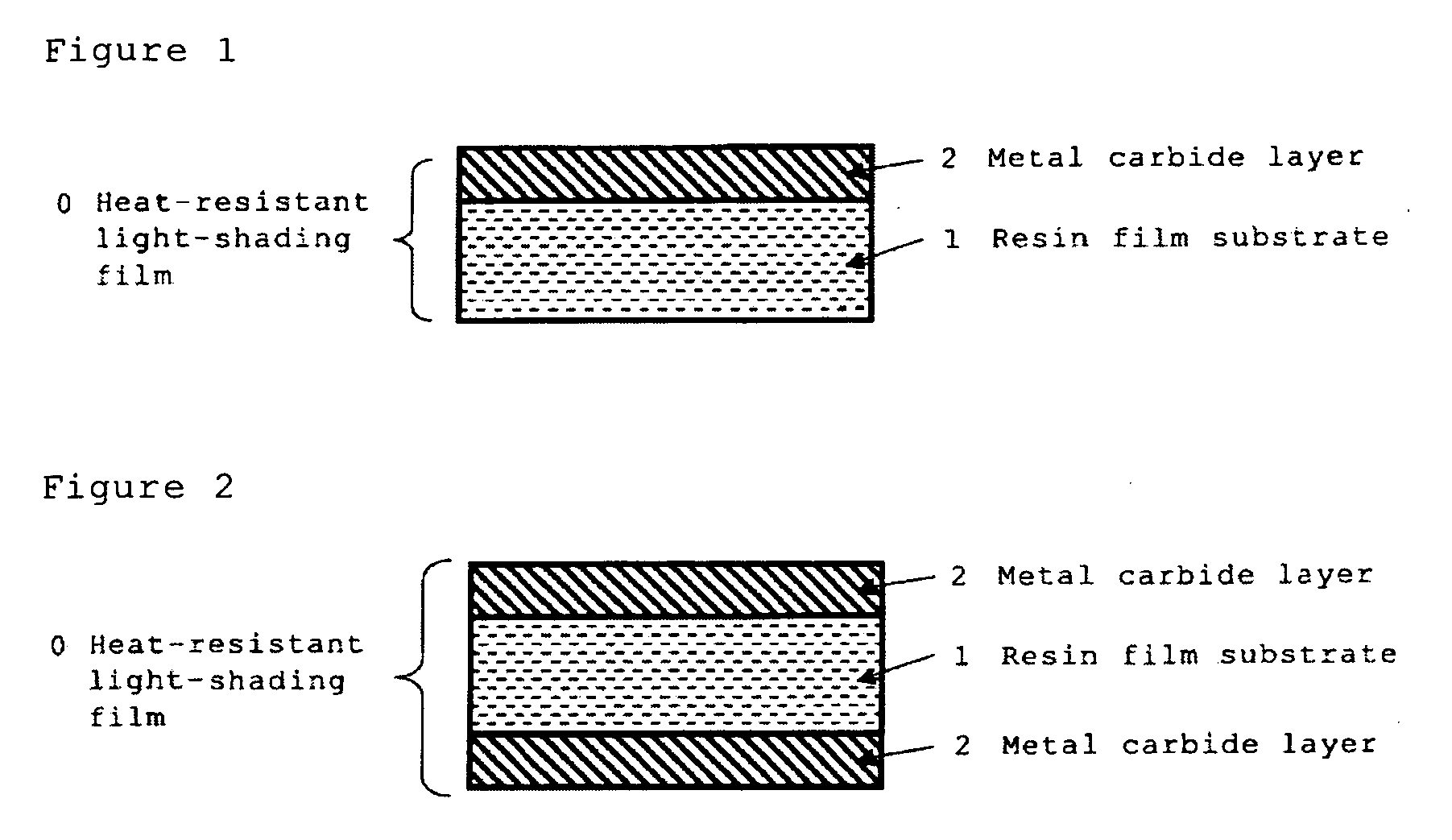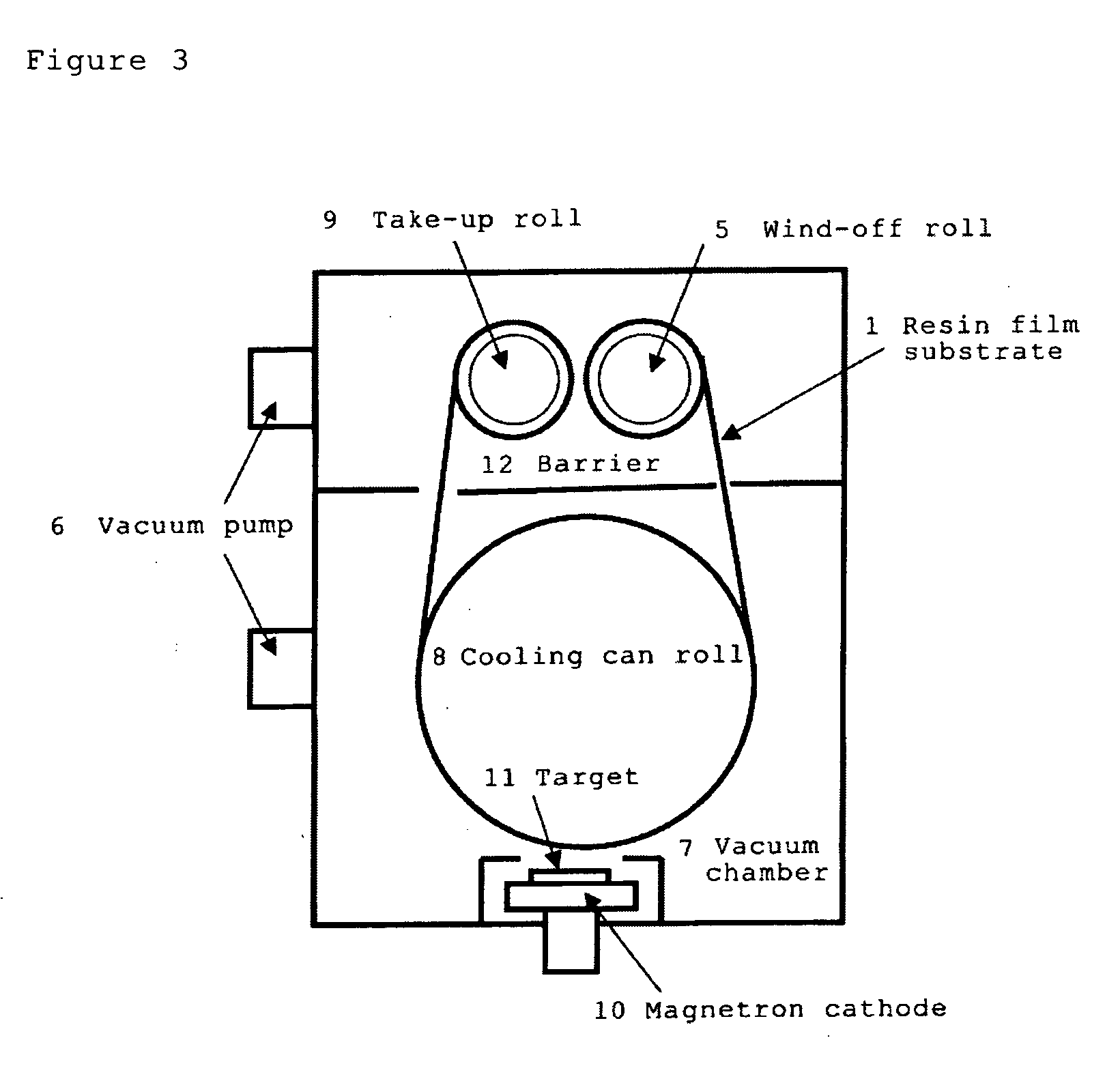Heat-resistant light-shading film and production method thereof, and diaphragm or light intensity adjusting device using the same
a technology of heat-resistant lightshade and film, which is applied in the direction of instruments, applications, other domestic objects, etc., can solve the problems of metal plates grazing, large noise, and blade grazing, and achieves low deterioration of sliding and surface gloss characteristics, high electroconductivity, and high durability
- Summary
- Abstract
- Description
- Claims
- Application Information
AI Technical Summary
Benefits of technology
Problems solved by technology
Method used
Image
Examples
example 1
[0136]Using a reel-equipped sputtering unit illustrated in FIG. 3, a metal carbide layer was formed on a resin film substrate having a heat resistance of 200° C. or higher. First, a target 11 providing a layer material was set on a magnetron cathode 10 which was set in such a manner to face to the surface of a cooling can roll 8. A film transfer section comprising a wind-off roll 5, a cooling can roll 8, a take-up roll 9, and the like, was isolated from the magnetron cathode 10 with a diaphragm 12. Next, a rolled resin film substrate 1 was set on the wind-off roll 5.
[0137]As the resin film substrate, a polyimide (PI) film, having a thickness of 75 μm and a surface with a fine concavity and convexity structure with an arithmetic average height Ra of 0.5 μm obtained by applying a surface treatment by sand blasting, was used. This polyimide (PI) film was sufficiently dried by heating at a temperature of 200° C. or higher before sputtering.
[0138]Next, contents in a vacuum chamber 7 were...
example 2
[0147]A heat-resistant light-shading film was prepared under the same conditions as in Example 1 except that only thickness of the titanium carbide layer was changed to 110 nm by varying film transfer speed in sputtering. Kind of the target material, type, thickness and surface roughness of the polyimide were same to those in Example 1. Degree of vacuum in the vacuum chamber attained before starting the sputtering was 6×10−5 Pa or less. Content of carbon in the light-shading layer was same to that in Example 1. Content of oxygen in the layer quantitatively analyzed by an XPS was 0.4 in atomic number ratio O / Me. From the X-ray diffraction measurement, it was found that the layer was a TiC layer having a superior crystallinity. Cross-sectional observation by a TEM also revealed that it was a dense layer composed of crystal grains.
[0148]Evaluations (optical characteristics and heat resistance) of the resultant heat-resistant light-shading film were carried out by the same procedures an...
example 3
[0151]A heat-resistant light-shading film was prepared under the same conditions as in Example 2 except that the degree of vacuum in the vacuum chamber attained before starting the sputtering was 8×10−4 Pa and that a titanium carbide layers having a thickness of 550 nm was formed on the both sides of the film substrate by repeating the sputtering 5 times on the film substrate, among the sputtering conditions in Example 2. Kind of the target material, type, thickness and surface roughness of the polyimide were same to those in Example 1.
[0152]Evaluations (optical characteristics and heat resistance) of the resultant heat-resistant light-shading film were carried out by the same procedures and under the same conditions to those in Example 1. Film surface temperature in the sputtering time of the titanium carbide layer was measured through the inspection window of quartz glass in the reel-equipped sputtering unit by the infrared radiation thermometer in the same manner as in Example 1....
PUM
| Property | Measurement | Unit |
|---|---|---|
| Temperature | aaaaa | aaaaa |
| Temperature | aaaaa | aaaaa |
| Length | aaaaa | aaaaa |
Abstract
Description
Claims
Application Information
 Login to View More
Login to View More - R&D
- Intellectual Property
- Life Sciences
- Materials
- Tech Scout
- Unparalleled Data Quality
- Higher Quality Content
- 60% Fewer Hallucinations
Browse by: Latest US Patents, China's latest patents, Technical Efficacy Thesaurus, Application Domain, Technology Topic, Popular Technical Reports.
© 2025 PatSnap. All rights reserved.Legal|Privacy policy|Modern Slavery Act Transparency Statement|Sitemap|About US| Contact US: help@patsnap.com



